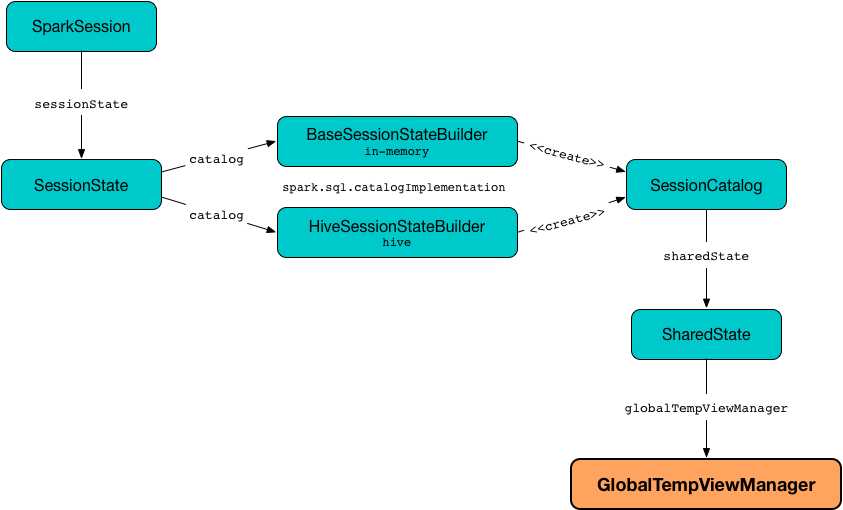
GlobalTempViewManager — Management Interface of Global Temporary Views
GlobalTempViewManager is the interface to manage global temporary views (that SessionCatalog uses when requested to create, alter or drop global temporary views).
Strictly speaking, GlobalTempViewManager simply manages the names of the global temporary views registered (and the corresponding logical plans) and has no interaction with other services in Spark SQL.
GlobalTempViewManager is available as globalTempViewManager property of a SharedState.

scala> :type spark
org.apache.spark.sql.SparkSession
scala> :type spark.sharedState.globalTempViewManager
org.apache.spark.sql.catalyst.catalog.GlobalTempViewManager| Method | Description |
|---|---|
|
|
Registers (creates) a global temporary view (as a LogicalPlan) by name Used when |
|
Finds the global view definition (as a LogicalPlan) for the given name if available Used when |
|
|
|
|
|
|
|
|
GlobalTempViewManager is created exclusively when SharedState is requested for one (for the very first time only as it is cached).
GlobalTempViewManager takes the name of the database when created.

| Name | Description |
|---|---|
|
Registry of global temporary view definitions as logical plans per view name. |
clear Method
clear(): Unitclear simply removes all the entries in the viewDefinitions internal registry.
|
Note
|
clear is used when SessionCatalog is requested to reset (that happens to be exclusively in the Spark SQL internal tests).
|
Creating (Registering) Global Temporary View (Definition) — create Method
create(
name: String,
viewDefinition: LogicalPlan,
overrideIfExists: Boolean): Unitcreate simply registers (adds) the input LogicalPlan under the input name.
create throws an AnalysisException when the input overrideIfExists flag is off and the viewDefinitions internal registry contains the input name.
Temporary view '[table]' already exists|
Note
|
create is used when SessionCatalog is requested to createGlobalTempView (when CreateViewCommand and CreateTempViewUsing logical commands are executed).
|
Retrieving Global View Definition Per Name — get Method
get(name: String): Option[LogicalPlan]get simply returns the LogicalPlan that was registered under the name if it defined.
|
Note
|
get is used when SessionCatalog is requested to getGlobalTempView, getTempViewOrPermanentTableMetadata, lookupRelation, isTemporaryTable or refreshTable.
|
Listing Global Temporary Views For Pattern — listViewNames Method
listViewNames(pattern: String): Seq[String]listViewNames simply gives a list of the global temporary views with names matching the input pattern.
|
Note
|
listViewNames is used exclusively when SessionCatalog is requested to listTables
|
Removing (De-Registering) Global Temporary View — remove Method
remove(name: String): Booleanremove simply tries to remove the name from the viewDefinitions internal registry and returns true when removed or false otherwise.
|
Note
|
remove is used when SessionCatalog is requested to drop a global temporary view or table.
|
rename Method
rename(oldName: String, newName: String): Booleanrename…FIXME
|
Note
|
rename is used when…FIXME
|
update Method
update(name: String, viewDefinition: LogicalPlan): Booleanupdate…FIXME
|
Note
|
update is used exclusively when SessionCatalog is requested to alter a global temporary view.
|